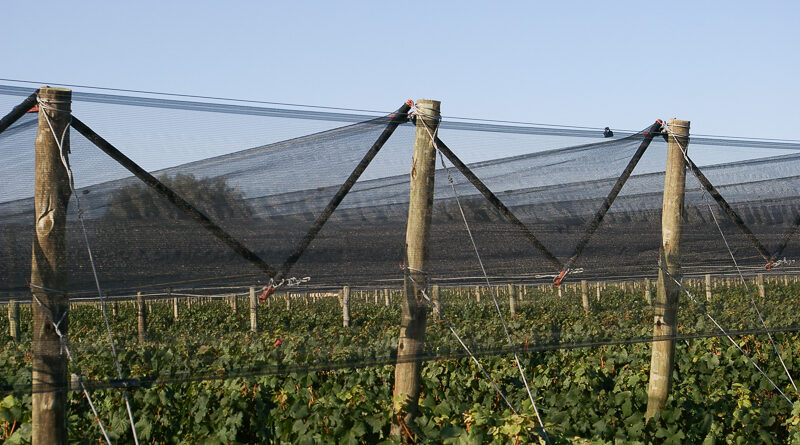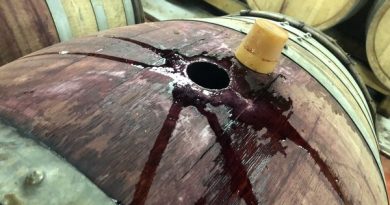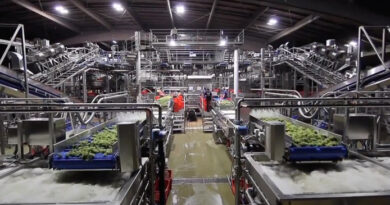Dealing with hail, a viticultural hazard that’s becoming more common
One of the big threats to many wine regions is hail. Once the vines have their foliage, hail can destroy a vineyard in just a few minutes. And one of the cruel things is that the damage caused often isn’t just for the current vintage: if it is severe enough, it can affect the following year’s growth also.
How hail forms
Hail forms in tall clouds with strong upward air motion (updrafts). These are most often cumulonimbus clouds, and they are incredibly tall and very wide – they need to be about 5 km wide for hail to form. What happens is that inside the cloud water droplets rise with the updrafts, and they then become supercooled: this means that they are still in the liquid phase but are below 0 °C. Water can go well below freezing in the supercooled state without forming ice if there are no nucleation sites present. But in these clouds there are, in the form of dust particles or pollen in the atmosphere. Ice forms around these, and the hailstone begins to take shape. When these hailstones – which grow in size as they rise in the cloud – become heavy enough, they fall to the ground.
Hail is most common in mid-latitudes, and in high-altitude regions. It’s rare in the tropics. And it can do a lot of damage. In June 2008, hail damaged 30 000 new cars at Volkswagen’s plant in Emden, Germany (here). Volkswagen seem to be unlucky on this front: five years later, another 17 000 cars were affected at their HQ in Wolfsberg (here).
In vineyards, there’s a sorry catalogue of disasters, and with climate chaos they seem to be happening more frequently. For example, on May 26th 2018 Bordeaux experienced hail that affected 7000 hectares of vineyards. On April 17th 2020 there was more hail in the region, this time affecting around 800 hectares of Entre Deux Mers and Saint-Emilion. Beaujolais was hailed in 2016 and 2017, and Burgundy suffered damage to 5000 hectares in 2014, with more problems in 2016. Often, damage is quite localized: one vineyard with be hit but another one close by might be fine. The worry of hail has prompted growers in many regions to band together to try to defend themselves against it.
Protecting against hail
The most effective defence is a physical barrier. In Argentina’s Mendoza region, such is the ever-present threat that hail netting is employed in some of the top vineyard sites. This can take the form of ‘cathedral’ netting covering the whole vineyard in a tent-like cover, which also has the side effect of slightly reducing solar radiation. Or it can be netting more closely resembling bird netting, primarily protecting the fruit zone from damage. It’s really expensive, though, and can only be justified in top sites. It also alters the terroir a bit by reducing the light intensity that the vines experience, which might be fine in sunny Mendoza but could be a problem elsewhere.

Another approach is to try to stop damaging hail from forming in the first place. This is through seeding the clouds so that there are far more nucleation sites. The result is more hail formation, but the hailstones are much smaller and will melt before they get to ground level. The most commonly used substance for this is silver iodide, and this needs to find its way into the cloud so it can act. Potassium iodide, calcium chloride and dry ice also do the same thing.
There are different ways of getting the nucleation material into the cloud. One common method is to have a network of generators that heat up the silver iodide so it rushes upwards and is taken up into the updraft. Another is to use rockets fired into the cloud from the ground, or to seed from an aeroplane. A further technique is to use helium balloons which rise into the cloud and then release the nucleating material at the right altitude. First, though, the offending clouds need to be spotted. The best way is to use a Doppler radar, but these cost several million Euros. X-band radar is next best: this is more affordable, but gives a higher false positive rate.
Last week (27 January 2021) the winegrowers of Saint-Emilion decided to implement a joint hail defence network that will cover 7500 hectares, involving some 900 growers. The system is Selerys, and it involves a radar to detect potential hail clouds, and then a series of 37 launchers. These release helium balloons that get sucked up by the updrafts and then at the right altitude release 200 g of calcium chloride to act as a nucleating agent.
ANELFA is a non-profit organization that began in the 1950s that studies and prevents hail in France. In 2015, working through a subsidiary organization ARELFA Bourgogne (Association Régionale d’Etude et de Lutte contre les Fléaux Atmosphériques en Bourgogne) they installed 126 ground generators in Burgundy to protect 42 000 hectares of vineyards. ANELFA also worked with the University of Budapest to protect the Tokaji region, installing 68 generators in the region.
There is a major hail control program in Mendoza, Argentina, which is financed by the ministry of the economy. They have two radars, four twin-engined planes and 12 ground generators.
Does seeding work? One study shows that if ground seeding is done three hours before the hail would have otherwise fallen, with a 10-km mesh silver iodide generator network located in the developing hailstorm areas, with each generator burning about 9 g of silver iodide per hour, the hailfall energy of the most severe hail days is decreased by about 50%. So the answer is yes, but not perfectly.
One commonly used technique that doesn’t seem to work is the use of hail cannons. The idea behind them sounds interesting: they release a sonic boom that is supposed to disrupt the formation of hailstones. But there is no proof that they work, and most scientists cast doubt that they could (although it is hard to prove that they don’t).




